Leadership and Change Management: A Case Study on HSBC Bank Strategies
VerifiedAdded on 2022/08/21
|12
|3417
|26
Case Study
AI Summary
This case study examines change management strategies implemented at HSBC bank. It analyzes the internal and external drivers for change, including economic factors, technological advancements, and market trends. The study explores how HSBC addressed resistance to change, particularly employee concerns regarding new strategies, by implementing a four-step model focusing on staff attitudes, education, and employee participation. The report applies Kurt Lewin's and Kotter's change management models to the HSBC case, detailing the stages of unfreezing, change, and refreezing, and the eight-step approach, respectively. It also discusses the triple bottom line approach adopted by the bank. The case highlights the rational and emotional resistance to change, and the methods employed by HSBC, such as training programs, open communication, and team empowerment, to mitigate these challenges. The study concludes with recommendations for effective change management, emphasizing the importance of leadership, communication, and employee involvement in achieving organizational goals and maintaining a competitive advantage in the banking sector.
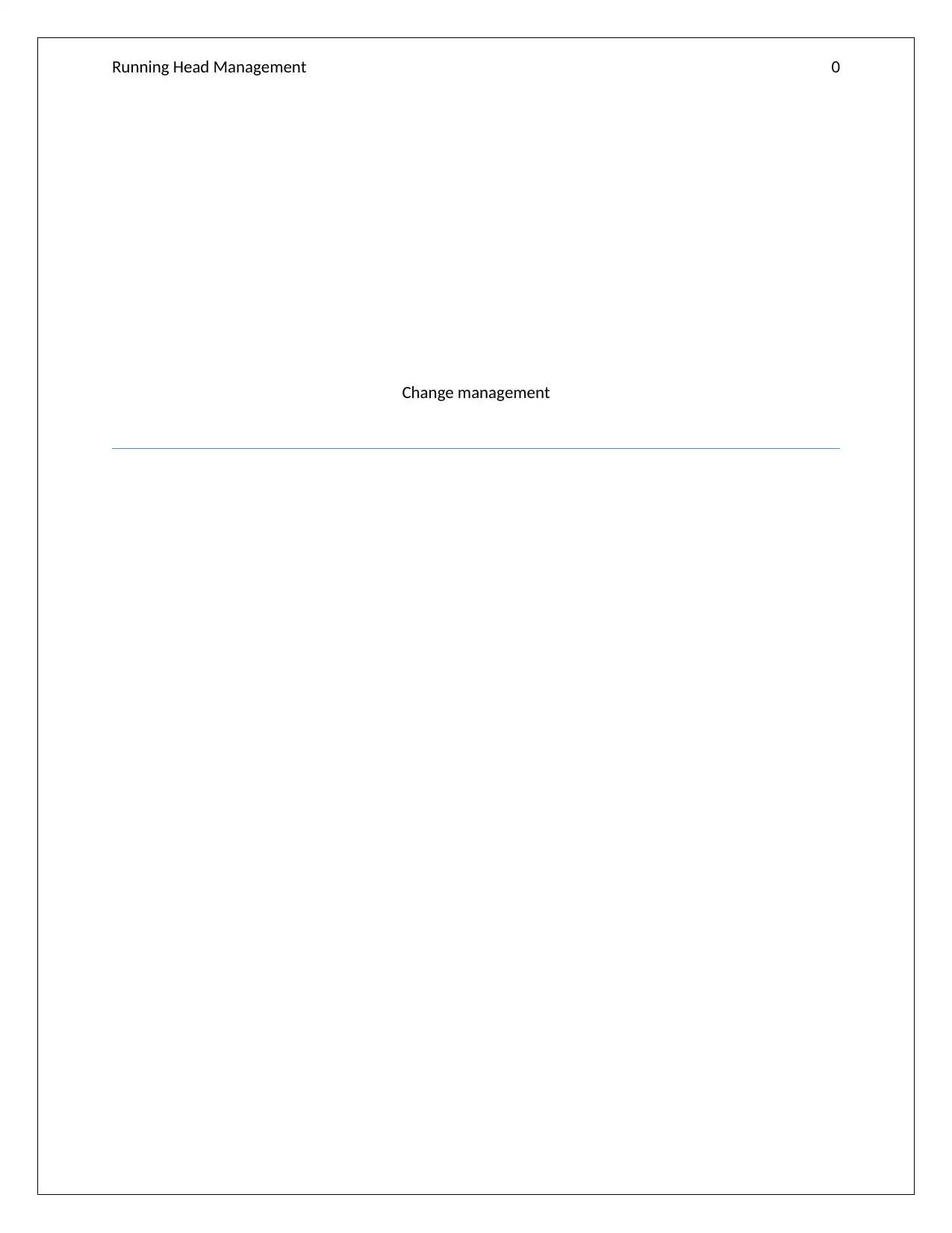
Running Head Management 0
Change management
Change management
Paraphrase This Document
Need a fresh take? Get an instant paraphrase of this document with our AI Paraphraser
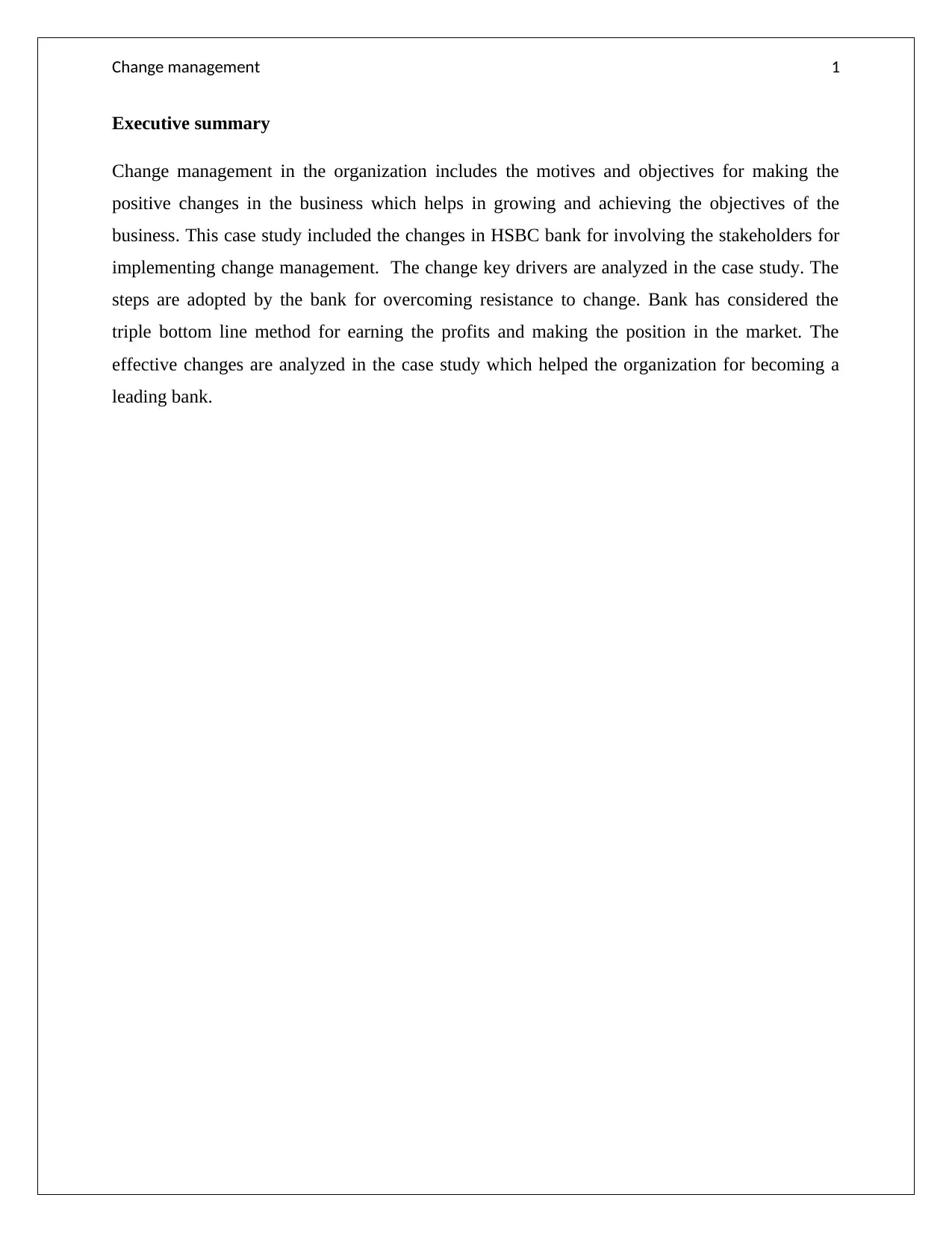
Change management 1
Executive summary
Change management in the organization includes the motives and objectives for making the
positive changes in the business which helps in growing and achieving the objectives of the
business. This case study included the changes in HSBC bank for involving the stakeholders for
implementing change management. The change key drivers are analyzed in the case study. The
steps are adopted by the bank for overcoming resistance to change. Bank has considered the
triple bottom line method for earning the profits and making the position in the market. The
effective changes are analyzed in the case study which helped the organization for becoming a
leading bank.
Executive summary
Change management in the organization includes the motives and objectives for making the
positive changes in the business which helps in growing and achieving the objectives of the
business. This case study included the changes in HSBC bank for involving the stakeholders for
implementing change management. The change key drivers are analyzed in the case study. The
steps are adopted by the bank for overcoming resistance to change. Bank has considered the
triple bottom line method for earning the profits and making the position in the market. The
effective changes are analyzed in the case study which helped the organization for becoming a
leading bank.
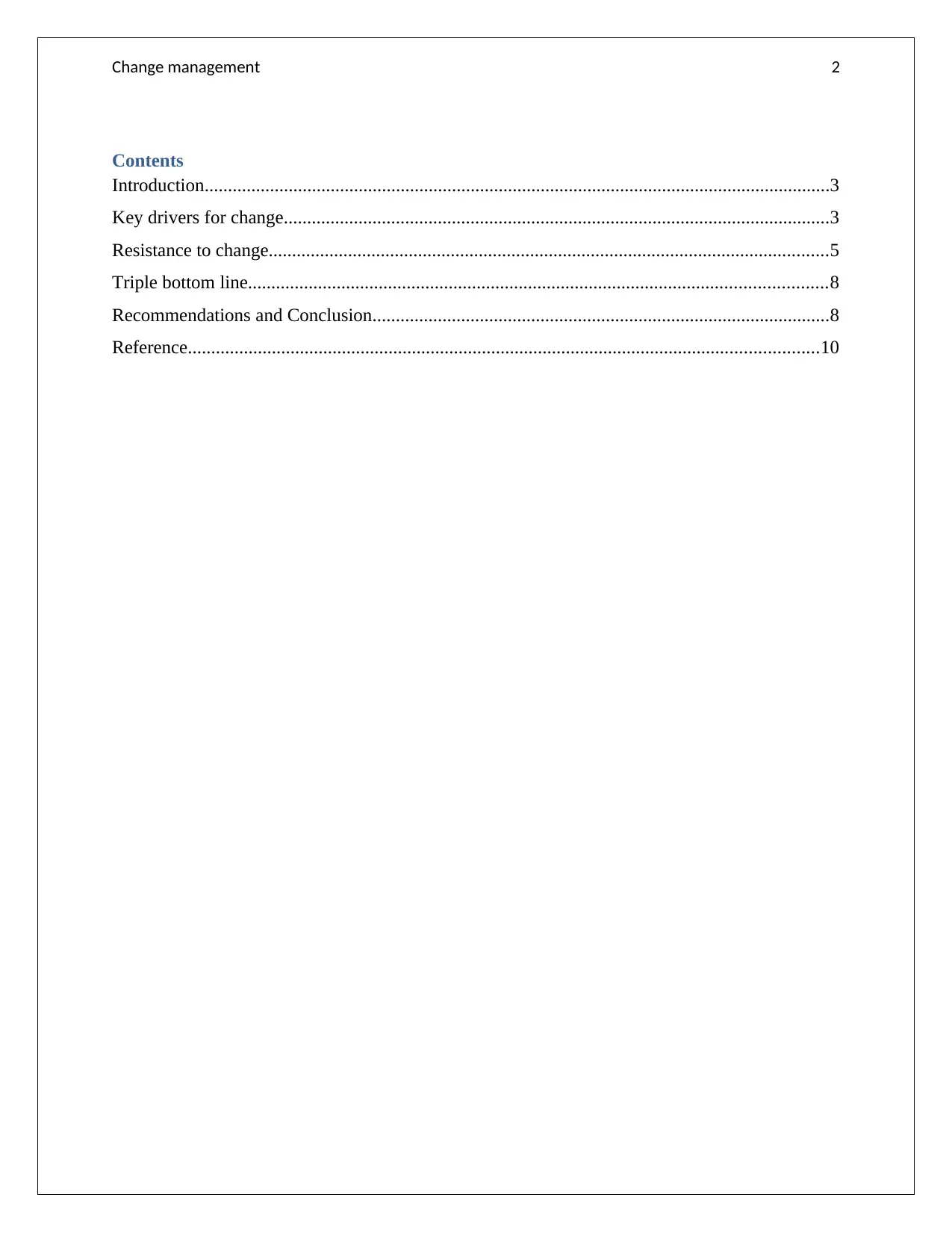
Change management 2
Contents
Introduction......................................................................................................................................3
Key drivers for change.....................................................................................................................3
Resistance to change........................................................................................................................5
Triple bottom line............................................................................................................................8
Recommendations and Conclusion..................................................................................................8
Reference.......................................................................................................................................10
Contents
Introduction......................................................................................................................................3
Key drivers for change.....................................................................................................................3
Resistance to change........................................................................................................................5
Triple bottom line............................................................................................................................8
Recommendations and Conclusion..................................................................................................8
Reference.......................................................................................................................................10
⊘ This is a preview!⊘
Do you want full access?
Subscribe today to unlock all pages.

Trusted by 1+ million students worldwide
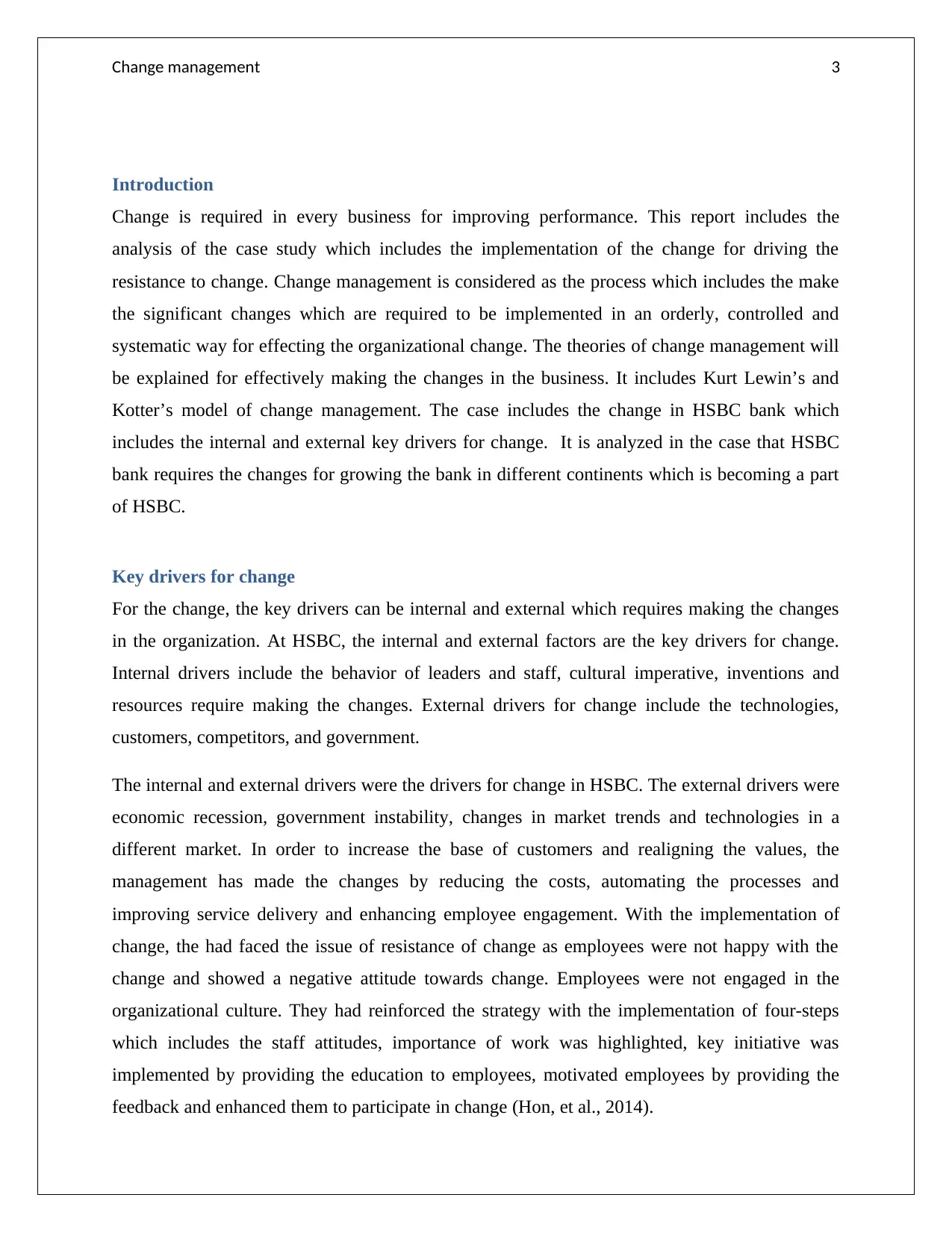
Change management 3
Introduction
Change is required in every business for improving performance. This report includes the
analysis of the case study which includes the implementation of the change for driving the
resistance to change. Change management is considered as the process which includes the make
the significant changes which are required to be implemented in an orderly, controlled and
systematic way for effecting the organizational change. The theories of change management will
be explained for effectively making the changes in the business. It includes Kurt Lewin’s and
Kotter’s model of change management. The case includes the change in HSBC bank which
includes the internal and external key drivers for change. It is analyzed in the case that HSBC
bank requires the changes for growing the bank in different continents which is becoming a part
of HSBC.
Key drivers for change
For the change, the key drivers can be internal and external which requires making the changes
in the organization. At HSBC, the internal and external factors are the key drivers for change.
Internal drivers include the behavior of leaders and staff, cultural imperative, inventions and
resources require making the changes. External drivers for change include the technologies,
customers, competitors, and government.
The internal and external drivers were the drivers for change in HSBC. The external drivers were
economic recession, government instability, changes in market trends and technologies in a
different market. In order to increase the base of customers and realigning the values, the
management has made the changes by reducing the costs, automating the processes and
improving service delivery and enhancing employee engagement. With the implementation of
change, the had faced the issue of resistance of change as employees were not happy with the
change and showed a negative attitude towards change. Employees were not engaged in the
organizational culture. They had reinforced the strategy with the implementation of four-steps
which includes the staff attitudes, importance of work was highlighted, key initiative was
implemented by providing the education to employees, motivated employees by providing the
feedback and enhanced them to participate in change (Hon, et al., 2014).
Introduction
Change is required in every business for improving performance. This report includes the
analysis of the case study which includes the implementation of the change for driving the
resistance to change. Change management is considered as the process which includes the make
the significant changes which are required to be implemented in an orderly, controlled and
systematic way for effecting the organizational change. The theories of change management will
be explained for effectively making the changes in the business. It includes Kurt Lewin’s and
Kotter’s model of change management. The case includes the change in HSBC bank which
includes the internal and external key drivers for change. It is analyzed in the case that HSBC
bank requires the changes for growing the bank in different continents which is becoming a part
of HSBC.
Key drivers for change
For the change, the key drivers can be internal and external which requires making the changes
in the organization. At HSBC, the internal and external factors are the key drivers for change.
Internal drivers include the behavior of leaders and staff, cultural imperative, inventions and
resources require making the changes. External drivers for change include the technologies,
customers, competitors, and government.
The internal and external drivers were the drivers for change in HSBC. The external drivers were
economic recession, government instability, changes in market trends and technologies in a
different market. In order to increase the base of customers and realigning the values, the
management has made the changes by reducing the costs, automating the processes and
improving service delivery and enhancing employee engagement. With the implementation of
change, the had faced the issue of resistance of change as employees were not happy with the
change and showed a negative attitude towards change. Employees were not engaged in the
organizational culture. They had reinforced the strategy with the implementation of four-steps
which includes the staff attitudes, importance of work was highlighted, key initiative was
implemented by providing the education to employees, motivated employees by providing the
feedback and enhanced them to participate in change (Hon, et al., 2014).
Paraphrase This Document
Need a fresh take? Get an instant paraphrase of this document with our AI Paraphraser
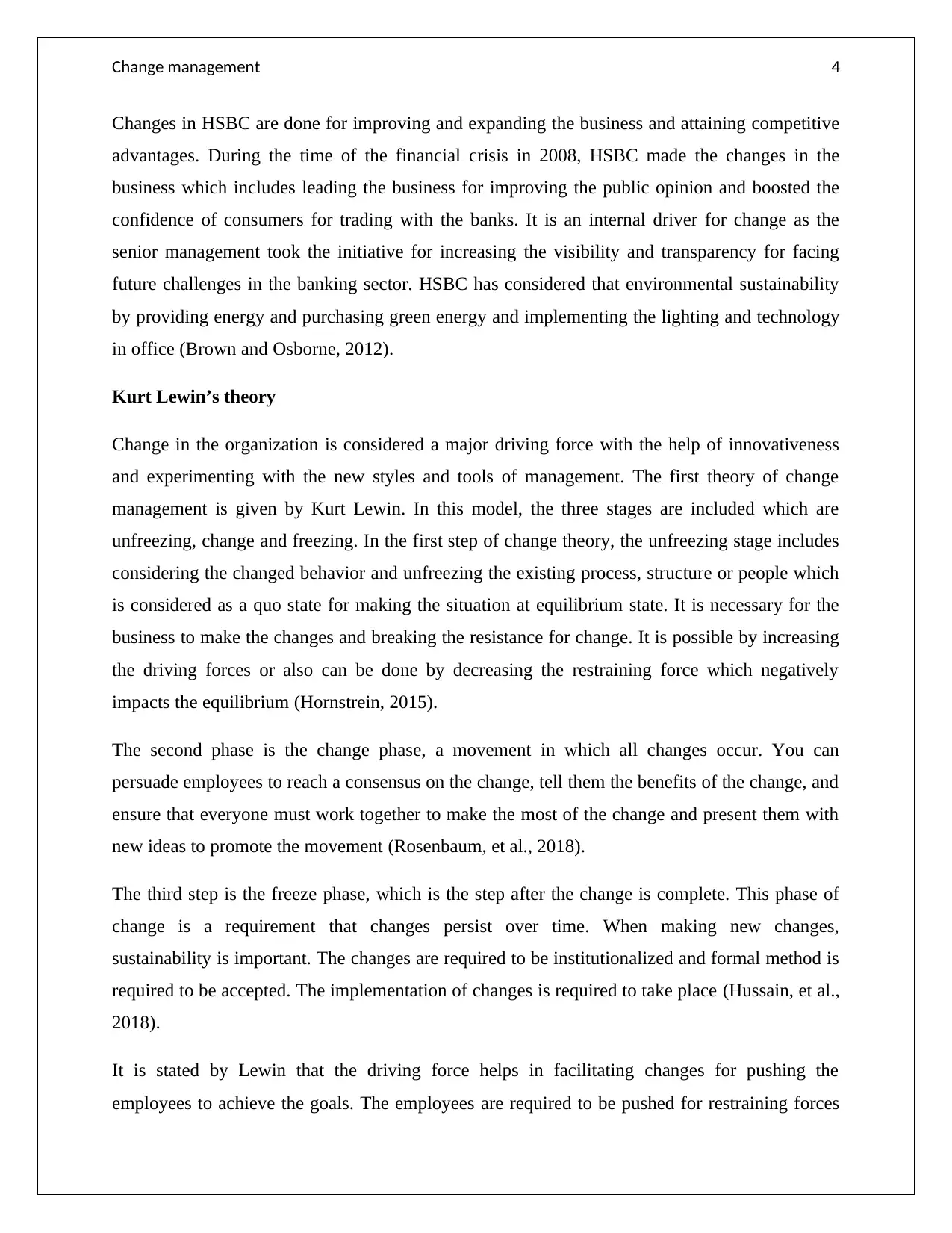
Change management 4
Changes in HSBC are done for improving and expanding the business and attaining competitive
advantages. During the time of the financial crisis in 2008, HSBC made the changes in the
business which includes leading the business for improving the public opinion and boosted the
confidence of consumers for trading with the banks. It is an internal driver for change as the
senior management took the initiative for increasing the visibility and transparency for facing
future challenges in the banking sector. HSBC has considered that environmental sustainability
by providing energy and purchasing green energy and implementing the lighting and technology
in office (Brown and Osborne, 2012).
Kurt Lewin’s theory
Change in the organization is considered a major driving force with the help of innovativeness
and experimenting with the new styles and tools of management. The first theory of change
management is given by Kurt Lewin. In this model, the three stages are included which are
unfreezing, change and freezing. In the first step of change theory, the unfreezing stage includes
considering the changed behavior and unfreezing the existing process, structure or people which
is considered as a quo state for making the situation at equilibrium state. It is necessary for the
business to make the changes and breaking the resistance for change. It is possible by increasing
the driving forces or also can be done by decreasing the restraining force which negatively
impacts the equilibrium (Hornstrein, 2015).
The second phase is the change phase, a movement in which all changes occur. You can
persuade employees to reach a consensus on the change, tell them the benefits of the change, and
ensure that everyone must work together to make the most of the change and present them with
new ideas to promote the movement (Rosenbaum, et al., 2018).
The third step is the freeze phase, which is the step after the change is complete. This phase of
change is a requirement that changes persist over time. When making new changes,
sustainability is important. The changes are required to be institutionalized and formal method is
required to be accepted. The implementation of changes is required to take place (Hussain, et al.,
2018).
It is stated by Lewin that the driving force helps in facilitating changes for pushing the
employees to achieve the goals. The employees are required to be pushed for restraining forces
Changes in HSBC are done for improving and expanding the business and attaining competitive
advantages. During the time of the financial crisis in 2008, HSBC made the changes in the
business which includes leading the business for improving the public opinion and boosted the
confidence of consumers for trading with the banks. It is an internal driver for change as the
senior management took the initiative for increasing the visibility and transparency for facing
future challenges in the banking sector. HSBC has considered that environmental sustainability
by providing energy and purchasing green energy and implementing the lighting and technology
in office (Brown and Osborne, 2012).
Kurt Lewin’s theory
Change in the organization is considered a major driving force with the help of innovativeness
and experimenting with the new styles and tools of management. The first theory of change
management is given by Kurt Lewin. In this model, the three stages are included which are
unfreezing, change and freezing. In the first step of change theory, the unfreezing stage includes
considering the changed behavior and unfreezing the existing process, structure or people which
is considered as a quo state for making the situation at equilibrium state. It is necessary for the
business to make the changes and breaking the resistance for change. It is possible by increasing
the driving forces or also can be done by decreasing the restraining force which negatively
impacts the equilibrium (Hornstrein, 2015).
The second phase is the change phase, a movement in which all changes occur. You can
persuade employees to reach a consensus on the change, tell them the benefits of the change, and
ensure that everyone must work together to make the most of the change and present them with
new ideas to promote the movement (Rosenbaum, et al., 2018).
The third step is the freeze phase, which is the step after the change is complete. This phase of
change is a requirement that changes persist over time. When making new changes,
sustainability is important. The changes are required to be institutionalized and formal method is
required to be accepted. The implementation of changes is required to take place (Hussain, et al.,
2018).
It is stated by Lewin that the driving force helps in facilitating changes for pushing the
employees to achieve the goals. The employees are required to be pushed for restraining forces
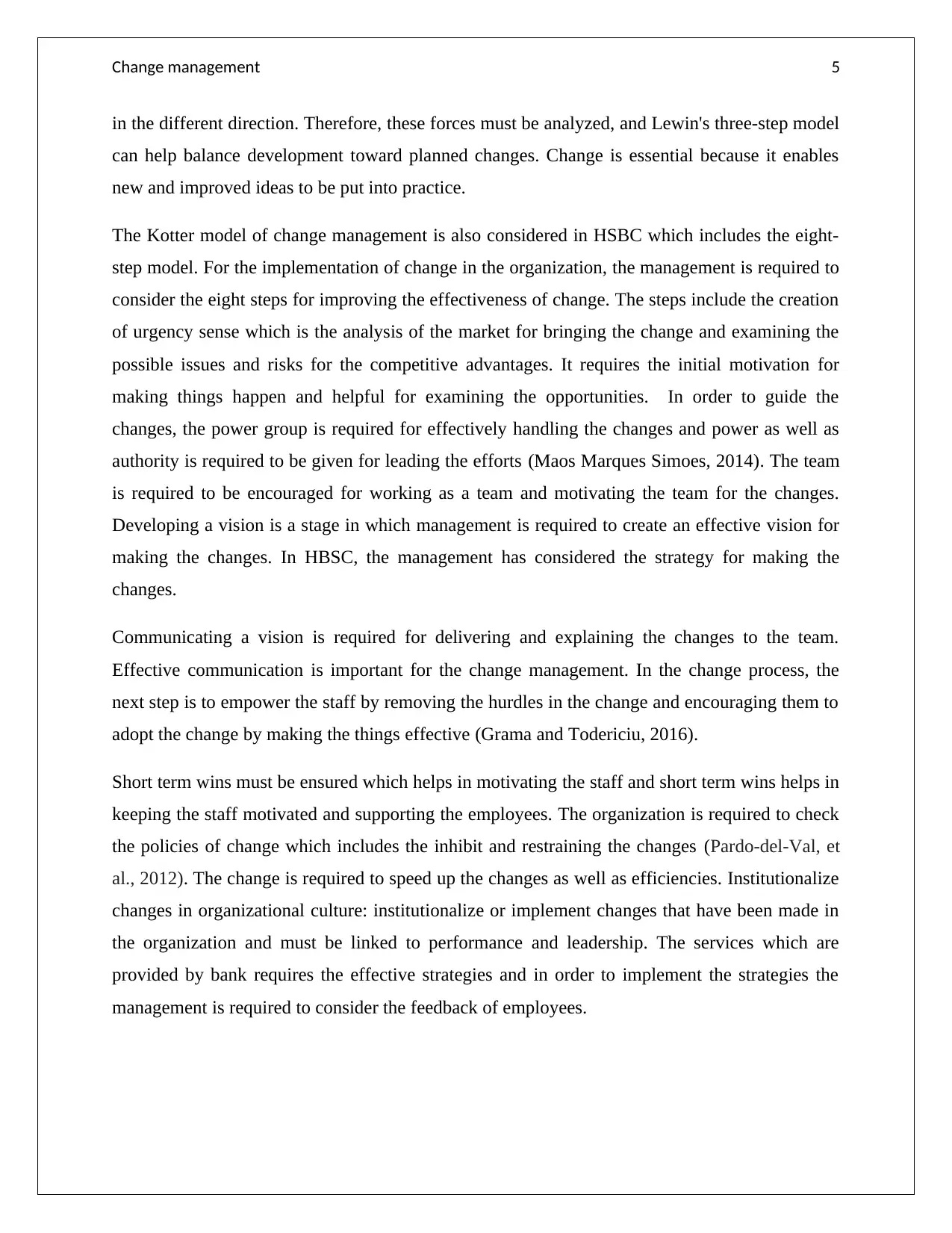
Change management 5
in the different direction. Therefore, these forces must be analyzed, and Lewin's three-step model
can help balance development toward planned changes. Change is essential because it enables
new and improved ideas to be put into practice.
The Kotter model of change management is also considered in HSBC which includes the eight-
step model. For the implementation of change in the organization, the management is required to
consider the eight steps for improving the effectiveness of change. The steps include the creation
of urgency sense which is the analysis of the market for bringing the change and examining the
possible issues and risks for the competitive advantages. It requires the initial motivation for
making things happen and helpful for examining the opportunities. In order to guide the
changes, the power group is required for effectively handling the changes and power as well as
authority is required to be given for leading the efforts (Maos Marques Simoes, 2014). The team
is required to be encouraged for working as a team and motivating the team for the changes.
Developing a vision is a stage in which management is required to create an effective vision for
making the changes. In HBSC, the management has considered the strategy for making the
changes.
Communicating a vision is required for delivering and explaining the changes to the team.
Effective communication is important for the change management. In the change process, the
next step is to empower the staff by removing the hurdles in the change and encouraging them to
adopt the change by making the things effective (Grama and Todericiu, 2016).
Short term wins must be ensured which helps in motivating the staff and short term wins helps in
keeping the staff motivated and supporting the employees. The organization is required to check
the policies of change which includes the inhibit and restraining the changes (Pardo-del-Val, et
al., 2012). The change is required to speed up the changes as well as efficiencies. Institutionalize
changes in organizational culture: institutionalize or implement changes that have been made in
the organization and must be linked to performance and leadership. The services which are
provided by bank requires the effective strategies and in order to implement the strategies the
management is required to consider the feedback of employees.
in the different direction. Therefore, these forces must be analyzed, and Lewin's three-step model
can help balance development toward planned changes. Change is essential because it enables
new and improved ideas to be put into practice.
The Kotter model of change management is also considered in HSBC which includes the eight-
step model. For the implementation of change in the organization, the management is required to
consider the eight steps for improving the effectiveness of change. The steps include the creation
of urgency sense which is the analysis of the market for bringing the change and examining the
possible issues and risks for the competitive advantages. It requires the initial motivation for
making things happen and helpful for examining the opportunities. In order to guide the
changes, the power group is required for effectively handling the changes and power as well as
authority is required to be given for leading the efforts (Maos Marques Simoes, 2014). The team
is required to be encouraged for working as a team and motivating the team for the changes.
Developing a vision is a stage in which management is required to create an effective vision for
making the changes. In HBSC, the management has considered the strategy for making the
changes.
Communicating a vision is required for delivering and explaining the changes to the team.
Effective communication is important for the change management. In the change process, the
next step is to empower the staff by removing the hurdles in the change and encouraging them to
adopt the change by making the things effective (Grama and Todericiu, 2016).
Short term wins must be ensured which helps in motivating the staff and short term wins helps in
keeping the staff motivated and supporting the employees. The organization is required to check
the policies of change which includes the inhibit and restraining the changes (Pardo-del-Val, et
al., 2012). The change is required to speed up the changes as well as efficiencies. Institutionalize
changes in organizational culture: institutionalize or implement changes that have been made in
the organization and must be linked to performance and leadership. The services which are
provided by bank requires the effective strategies and in order to implement the strategies the
management is required to consider the feedback of employees.
⊘ This is a preview!⊘
Do you want full access?
Subscribe today to unlock all pages.

Trusted by 1+ million students worldwide
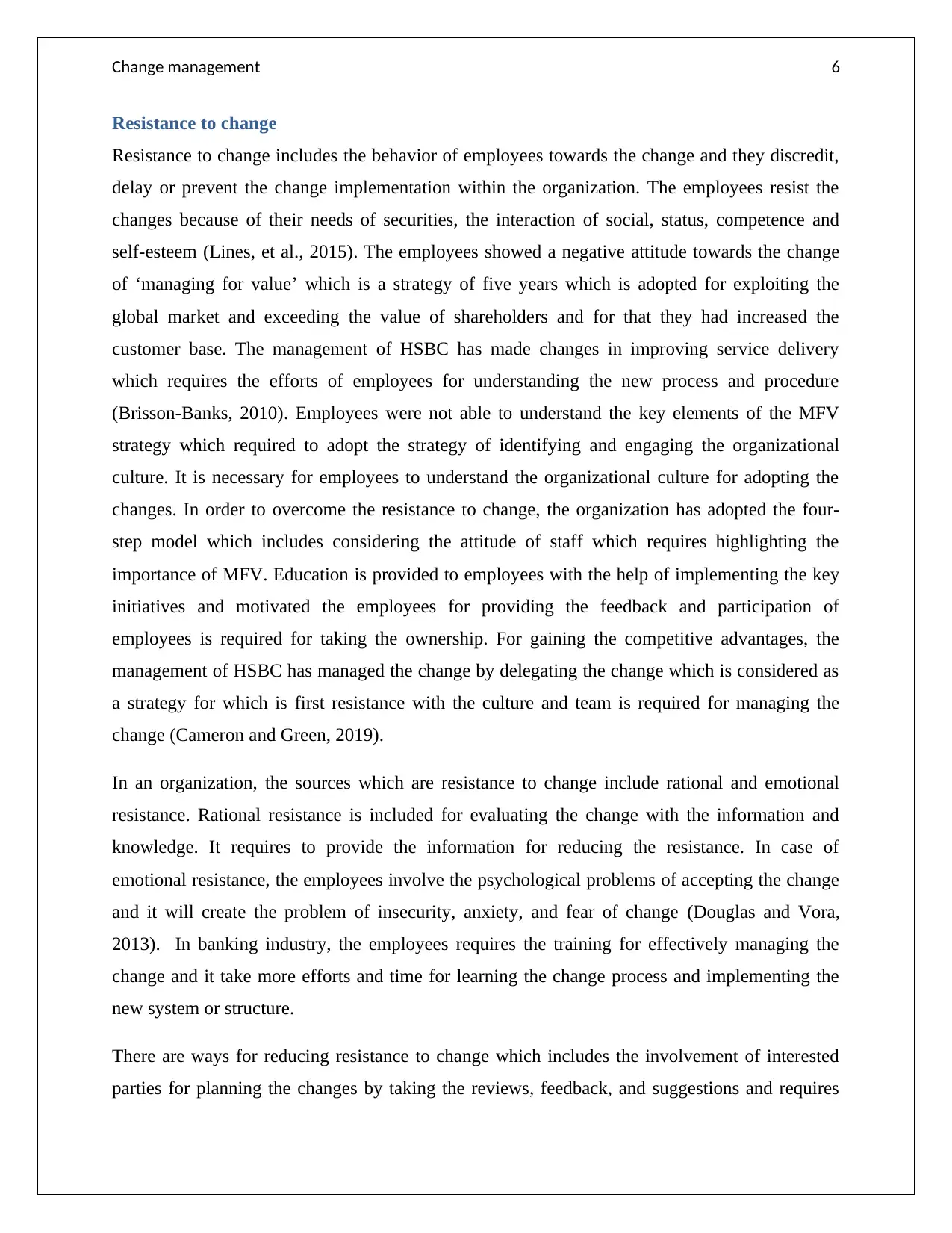
Change management 6
Resistance to change
Resistance to change includes the behavior of employees towards the change and they discredit,
delay or prevent the change implementation within the organization. The employees resist the
changes because of their needs of securities, the interaction of social, status, competence and
self-esteem (Lines, et al., 2015). The employees showed a negative attitude towards the change
of ‘managing for value’ which is a strategy of five years which is adopted for exploiting the
global market and exceeding the value of shareholders and for that they had increased the
customer base. The management of HSBC has made changes in improving service delivery
which requires the efforts of employees for understanding the new process and procedure
(Brisson-Banks, 2010). Employees were not able to understand the key elements of the MFV
strategy which required to adopt the strategy of identifying and engaging the organizational
culture. It is necessary for employees to understand the organizational culture for adopting the
changes. In order to overcome the resistance to change, the organization has adopted the four-
step model which includes considering the attitude of staff which requires highlighting the
importance of MFV. Education is provided to employees with the help of implementing the key
initiatives and motivated the employees for providing the feedback and participation of
employees is required for taking the ownership. For gaining the competitive advantages, the
management of HSBC has managed the change by delegating the change which is considered as
a strategy for which is first resistance with the culture and team is required for managing the
change (Cameron and Green, 2019).
In an organization, the sources which are resistance to change include rational and emotional
resistance. Rational resistance is included for evaluating the change with the information and
knowledge. It requires to provide the information for reducing the resistance. In case of
emotional resistance, the employees involve the psychological problems of accepting the change
and it will create the problem of insecurity, anxiety, and fear of change (Douglas and Vora,
2013). In banking industry, the employees requires the training for effectively managing the
change and it take more efforts and time for learning the change process and implementing the
new system or structure.
There are ways for reducing resistance to change which includes the involvement of interested
parties for planning the changes by taking the reviews, feedback, and suggestions and requires
Resistance to change
Resistance to change includes the behavior of employees towards the change and they discredit,
delay or prevent the change implementation within the organization. The employees resist the
changes because of their needs of securities, the interaction of social, status, competence and
self-esteem (Lines, et al., 2015). The employees showed a negative attitude towards the change
of ‘managing for value’ which is a strategy of five years which is adopted for exploiting the
global market and exceeding the value of shareholders and for that they had increased the
customer base. The management of HSBC has made changes in improving service delivery
which requires the efforts of employees for understanding the new process and procedure
(Brisson-Banks, 2010). Employees were not able to understand the key elements of the MFV
strategy which required to adopt the strategy of identifying and engaging the organizational
culture. It is necessary for employees to understand the organizational culture for adopting the
changes. In order to overcome the resistance to change, the organization has adopted the four-
step model which includes considering the attitude of staff which requires highlighting the
importance of MFV. Education is provided to employees with the help of implementing the key
initiatives and motivated the employees for providing the feedback and participation of
employees is required for taking the ownership. For gaining the competitive advantages, the
management of HSBC has managed the change by delegating the change which is considered as
a strategy for which is first resistance with the culture and team is required for managing the
change (Cameron and Green, 2019).
In an organization, the sources which are resistance to change include rational and emotional
resistance. Rational resistance is included for evaluating the change with the information and
knowledge. It requires to provide the information for reducing the resistance. In case of
emotional resistance, the employees involve the psychological problems of accepting the change
and it will create the problem of insecurity, anxiety, and fear of change (Douglas and Vora,
2013). In banking industry, the employees requires the training for effectively managing the
change and it take more efforts and time for learning the change process and implementing the
new system or structure.
There are ways for reducing resistance to change which includes the involvement of interested
parties for planning the changes by taking the reviews, feedback, and suggestions and requires
Paraphrase This Document
Need a fresh take? Get an instant paraphrase of this document with our AI Paraphraser
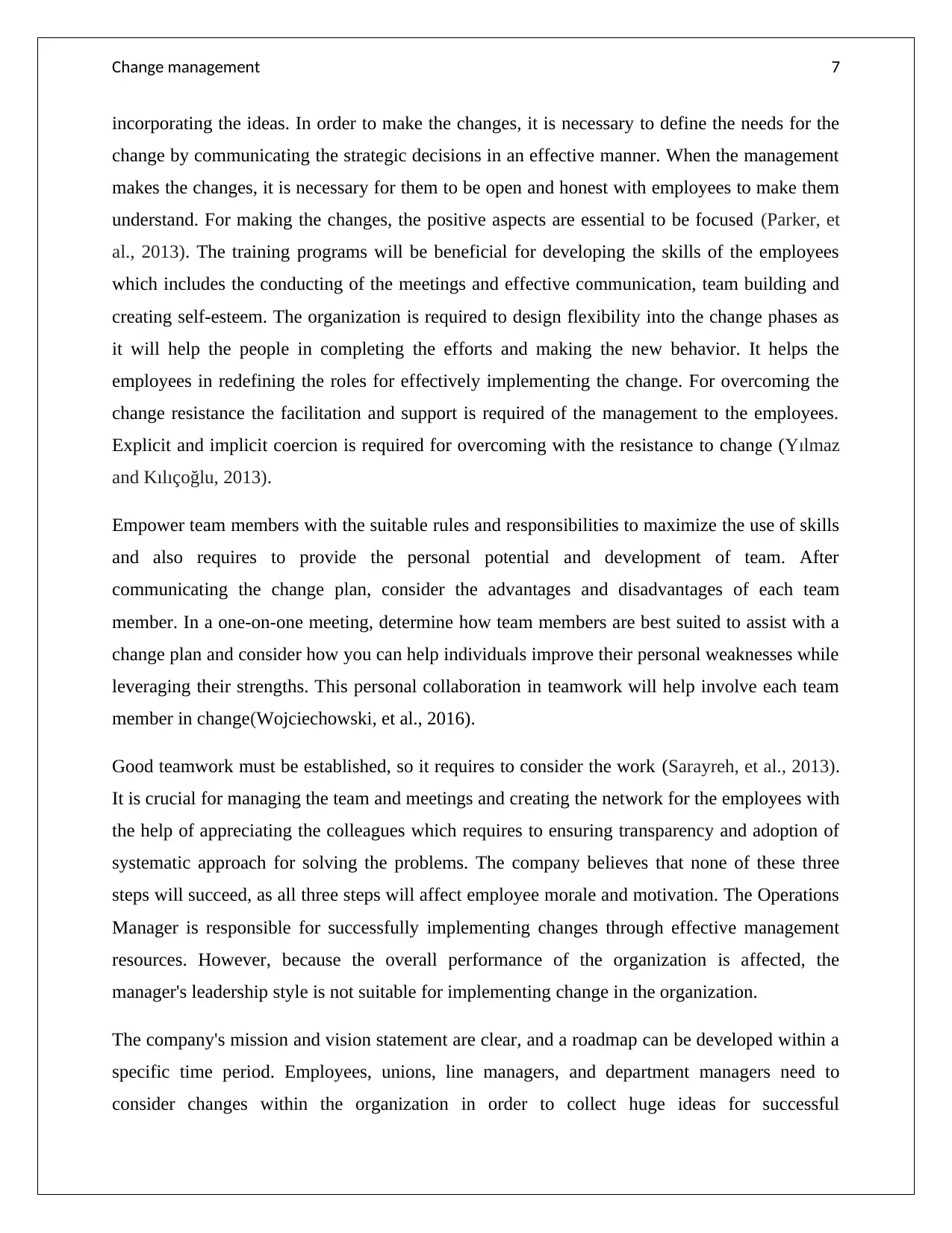
Change management 7
incorporating the ideas. In order to make the changes, it is necessary to define the needs for the
change by communicating the strategic decisions in an effective manner. When the management
makes the changes, it is necessary for them to be open and honest with employees to make them
understand. For making the changes, the positive aspects are essential to be focused (Parker, et
al., 2013). The training programs will be beneficial for developing the skills of the employees
which includes the conducting of the meetings and effective communication, team building and
creating self-esteem. The organization is required to design flexibility into the change phases as
it will help the people in completing the efforts and making the new behavior. It helps the
employees in redefining the roles for effectively implementing the change. For overcoming the
change resistance the facilitation and support is required of the management to the employees.
Explicit and implicit coercion is required for overcoming with the resistance to change (Yılmaz
and Kılıçoğlu, 2013).
Empower team members with the suitable rules and responsibilities to maximize the use of skills
and also requires to provide the personal potential and development of team. After
communicating the change plan, consider the advantages and disadvantages of each team
member. In a one-on-one meeting, determine how team members are best suited to assist with a
change plan and consider how you can help individuals improve their personal weaknesses while
leveraging their strengths. This personal collaboration in teamwork will help involve each team
member in change(Wojciechowski, et al., 2016).
Good teamwork must be established, so it requires to consider the work (Sarayreh, et al., 2013).
It is crucial for managing the team and meetings and creating the network for the employees with
the help of appreciating the colleagues which requires to ensuring transparency and adoption of
systematic approach for solving the problems. The company believes that none of these three
steps will succeed, as all three steps will affect employee morale and motivation. The Operations
Manager is responsible for successfully implementing changes through effective management
resources. However, because the overall performance of the organization is affected, the
manager's leadership style is not suitable for implementing change in the organization.
The company's mission and vision statement are clear, and a roadmap can be developed within a
specific time period. Employees, unions, line managers, and department managers need to
consider changes within the organization in order to collect huge ideas for successful
incorporating the ideas. In order to make the changes, it is necessary to define the needs for the
change by communicating the strategic decisions in an effective manner. When the management
makes the changes, it is necessary for them to be open and honest with employees to make them
understand. For making the changes, the positive aspects are essential to be focused (Parker, et
al., 2013). The training programs will be beneficial for developing the skills of the employees
which includes the conducting of the meetings and effective communication, team building and
creating self-esteem. The organization is required to design flexibility into the change phases as
it will help the people in completing the efforts and making the new behavior. It helps the
employees in redefining the roles for effectively implementing the change. For overcoming the
change resistance the facilitation and support is required of the management to the employees.
Explicit and implicit coercion is required for overcoming with the resistance to change (Yılmaz
and Kılıçoğlu, 2013).
Empower team members with the suitable rules and responsibilities to maximize the use of skills
and also requires to provide the personal potential and development of team. After
communicating the change plan, consider the advantages and disadvantages of each team
member. In a one-on-one meeting, determine how team members are best suited to assist with a
change plan and consider how you can help individuals improve their personal weaknesses while
leveraging their strengths. This personal collaboration in teamwork will help involve each team
member in change(Wojciechowski, et al., 2016).
Good teamwork must be established, so it requires to consider the work (Sarayreh, et al., 2013).
It is crucial for managing the team and meetings and creating the network for the employees with
the help of appreciating the colleagues which requires to ensuring transparency and adoption of
systematic approach for solving the problems. The company believes that none of these three
steps will succeed, as all three steps will affect employee morale and motivation. The Operations
Manager is responsible for successfully implementing changes through effective management
resources. However, because the overall performance of the organization is affected, the
manager's leadership style is not suitable for implementing change in the organization.
The company's mission and vision statement are clear, and a roadmap can be developed within a
specific time period. Employees, unions, line managers, and department managers need to
consider changes within the organization in order to collect huge ideas for successful
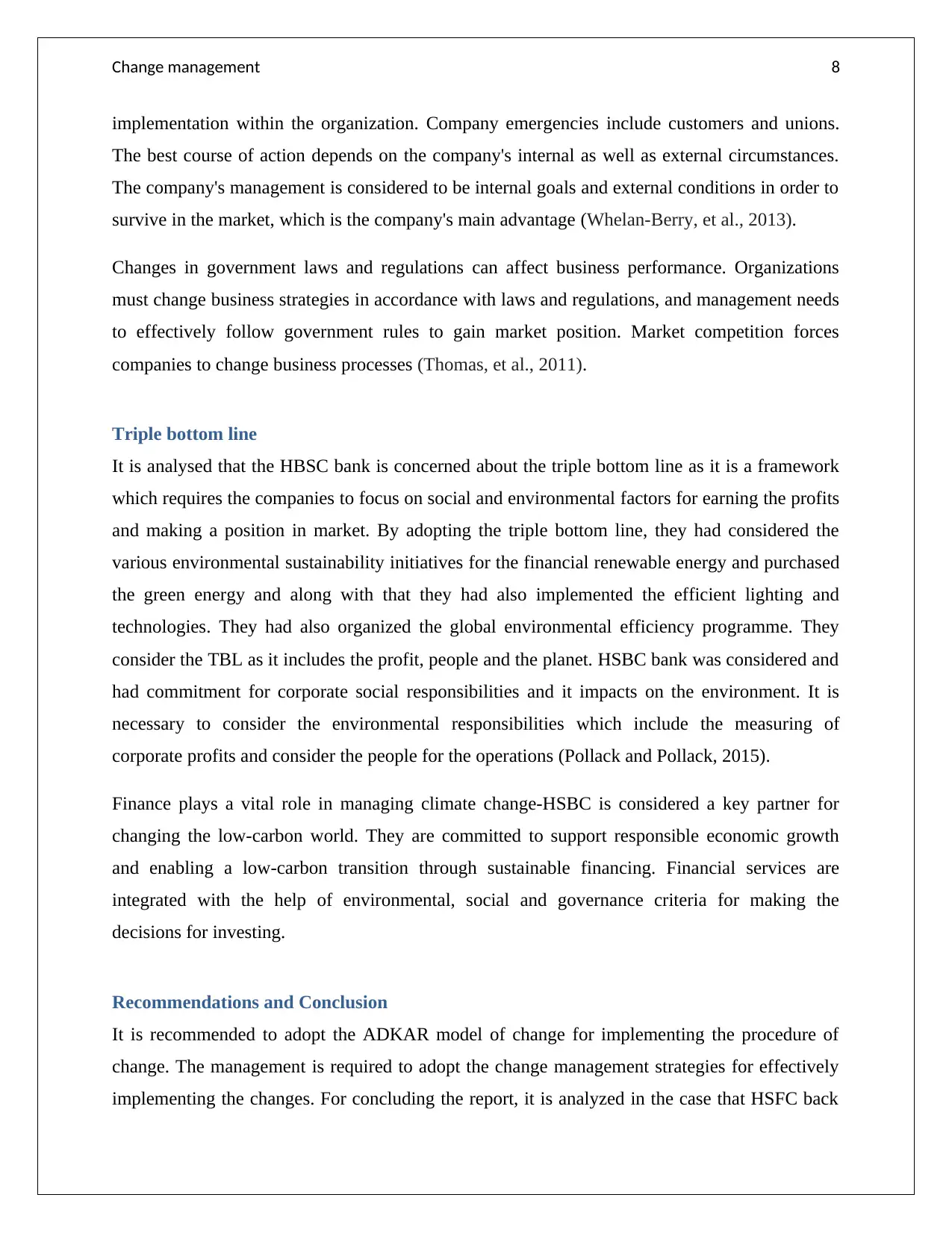
Change management 8
implementation within the organization. Company emergencies include customers and unions.
The best course of action depends on the company's internal as well as external circumstances.
The company's management is considered to be internal goals and external conditions in order to
survive in the market, which is the company's main advantage (Whelan-Berry, et al., 2013).
Changes in government laws and regulations can affect business performance. Organizations
must change business strategies in accordance with laws and regulations, and management needs
to effectively follow government rules to gain market position. Market competition forces
companies to change business processes (Thomas, et al., 2011).
Triple bottom line
It is analysed that the HBSC bank is concerned about the triple bottom line as it is a framework
which requires the companies to focus on social and environmental factors for earning the profits
and making a position in market. By adopting the triple bottom line, they had considered the
various environmental sustainability initiatives for the financial renewable energy and purchased
the green energy and along with that they had also implemented the efficient lighting and
technologies. They had also organized the global environmental efficiency programme. They
consider the TBL as it includes the profit, people and the planet. HSBC bank was considered and
had commitment for corporate social responsibilities and it impacts on the environment. It is
necessary to consider the environmental responsibilities which include the measuring of
corporate profits and consider the people for the operations (Pollack and Pollack, 2015).
Finance plays a vital role in managing climate change-HSBC is considered a key partner for
changing the low-carbon world. They are committed to support responsible economic growth
and enabling a low-carbon transition through sustainable financing. Financial services are
integrated with the help of environmental, social and governance criteria for making the
decisions for investing.
Recommendations and Conclusion
It is recommended to adopt the ADKAR model of change for implementing the procedure of
change. The management is required to adopt the change management strategies for effectively
implementing the changes. For concluding the report, it is analyzed in the case that HSFC back
implementation within the organization. Company emergencies include customers and unions.
The best course of action depends on the company's internal as well as external circumstances.
The company's management is considered to be internal goals and external conditions in order to
survive in the market, which is the company's main advantage (Whelan-Berry, et al., 2013).
Changes in government laws and regulations can affect business performance. Organizations
must change business strategies in accordance with laws and regulations, and management needs
to effectively follow government rules to gain market position. Market competition forces
companies to change business processes (Thomas, et al., 2011).
Triple bottom line
It is analysed that the HBSC bank is concerned about the triple bottom line as it is a framework
which requires the companies to focus on social and environmental factors for earning the profits
and making a position in market. By adopting the triple bottom line, they had considered the
various environmental sustainability initiatives for the financial renewable energy and purchased
the green energy and along with that they had also implemented the efficient lighting and
technologies. They had also organized the global environmental efficiency programme. They
consider the TBL as it includes the profit, people and the planet. HSBC bank was considered and
had commitment for corporate social responsibilities and it impacts on the environment. It is
necessary to consider the environmental responsibilities which include the measuring of
corporate profits and consider the people for the operations (Pollack and Pollack, 2015).
Finance plays a vital role in managing climate change-HSBC is considered a key partner for
changing the low-carbon world. They are committed to support responsible economic growth
and enabling a low-carbon transition through sustainable financing. Financial services are
integrated with the help of environmental, social and governance criteria for making the
decisions for investing.
Recommendations and Conclusion
It is recommended to adopt the ADKAR model of change for implementing the procedure of
change. The management is required to adopt the change management strategies for effectively
implementing the changes. For concluding the report, it is analyzed in the case that HSFC back
⊘ This is a preview!⊘
Do you want full access?
Subscribe today to unlock all pages.

Trusted by 1+ million students worldwide
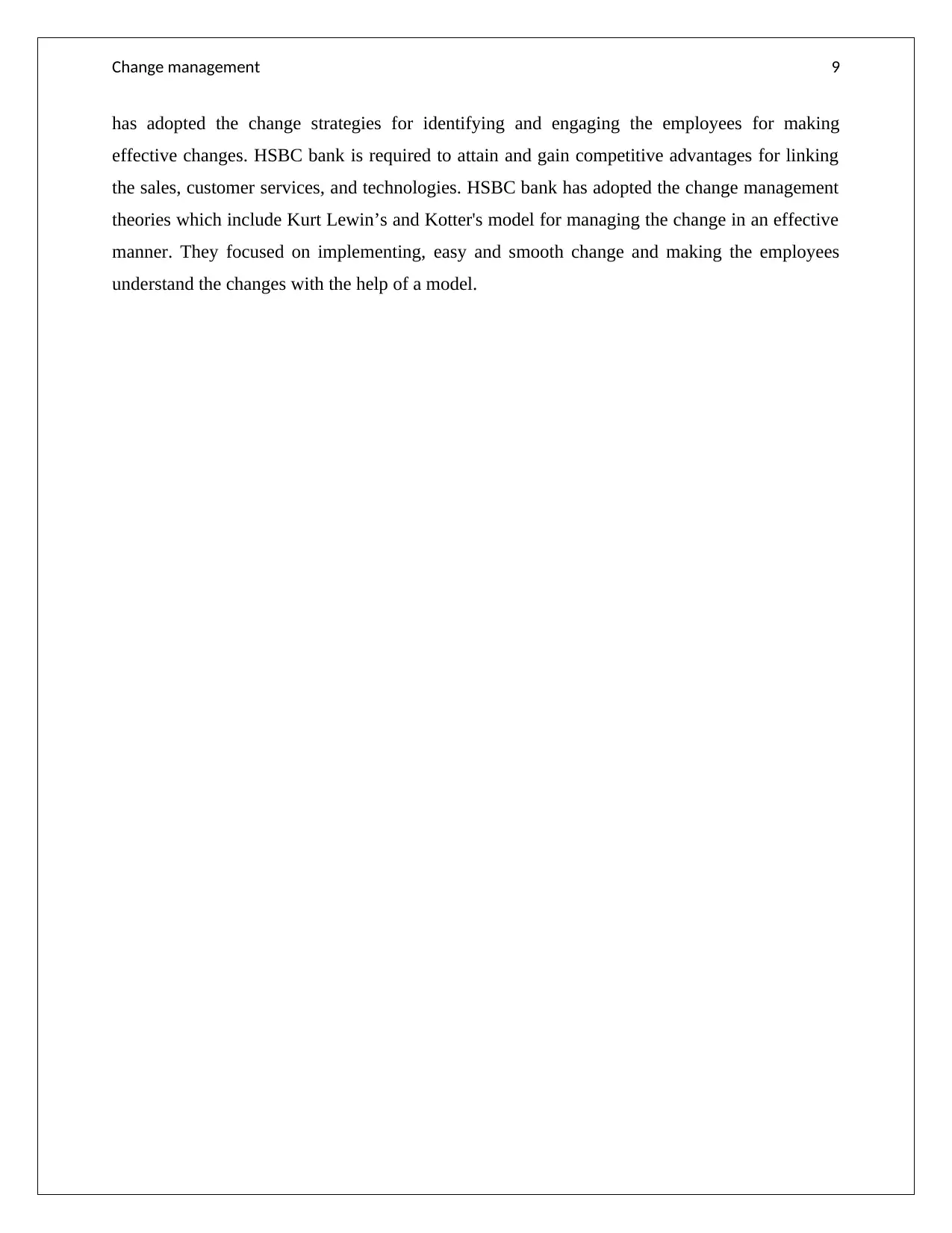
Change management 9
has adopted the change strategies for identifying and engaging the employees for making
effective changes. HSBC bank is required to attain and gain competitive advantages for linking
the sales, customer services, and technologies. HSBC bank has adopted the change management
theories which include Kurt Lewin’s and Kotter's model for managing the change in an effective
manner. They focused on implementing, easy and smooth change and making the employees
understand the changes with the help of a model.
has adopted the change strategies for identifying and engaging the employees for making
effective changes. HSBC bank is required to attain and gain competitive advantages for linking
the sales, customer services, and technologies. HSBC bank has adopted the change management
theories which include Kurt Lewin’s and Kotter's model for managing the change in an effective
manner. They focused on implementing, easy and smooth change and making the employees
understand the changes with the help of a model.
Paraphrase This Document
Need a fresh take? Get an instant paraphrase of this document with our AI Paraphraser
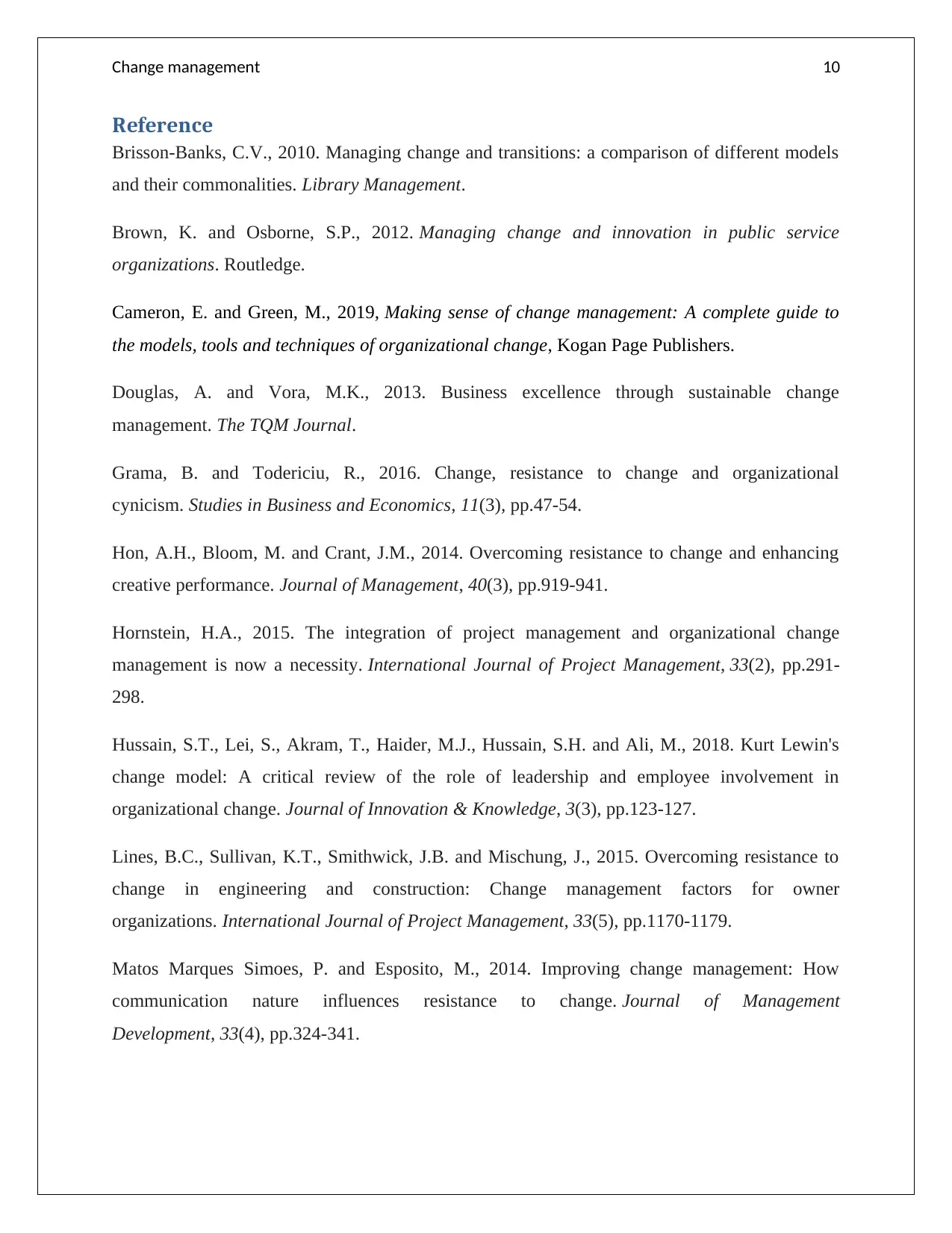
Change management 10
Reference
Brisson‐Banks, C.V., 2010. Managing change and transitions: a comparison of different models
and their commonalities. Library Management.
Brown, K. and Osborne, S.P., 2012. Managing change and innovation in public service
organizations. Routledge.
Cameron, E. and Green, M., 2019, Making sense of change management: A complete guide to
the models, tools and techniques of organizational change, Kogan Page Publishers.
Douglas, A. and Vora, M.K., 2013. Business excellence through sustainable change
management. The TQM Journal.
Grama, B. and Todericiu, R., 2016. Change, resistance to change and organizational
cynicism. Studies in Business and Economics, 11(3), pp.47-54.
Hon, A.H., Bloom, M. and Crant, J.M., 2014. Overcoming resistance to change and enhancing
creative performance. Journal of Management, 40(3), pp.919-941.
Hornstein, H.A., 2015. The integration of project management and organizational change
management is now a necessity. International Journal of Project Management, 33(2), pp.291-
298.
Hussain, S.T., Lei, S., Akram, T., Haider, M.J., Hussain, S.H. and Ali, M., 2018. Kurt Lewin's
change model: A critical review of the role of leadership and employee involvement in
organizational change. Journal of Innovation & Knowledge, 3(3), pp.123-127.
Lines, B.C., Sullivan, K.T., Smithwick, J.B. and Mischung, J., 2015. Overcoming resistance to
change in engineering and construction: Change management factors for owner
organizations. International Journal of Project Management, 33(5), pp.1170-1179.
Matos Marques Simoes, P. and Esposito, M., 2014. Improving change management: How
communication nature influences resistance to change. Journal of Management
Development, 33(4), pp.324-341.
Reference
Brisson‐Banks, C.V., 2010. Managing change and transitions: a comparison of different models
and their commonalities. Library Management.
Brown, K. and Osborne, S.P., 2012. Managing change and innovation in public service
organizations. Routledge.
Cameron, E. and Green, M., 2019, Making sense of change management: A complete guide to
the models, tools and techniques of organizational change, Kogan Page Publishers.
Douglas, A. and Vora, M.K., 2013. Business excellence through sustainable change
management. The TQM Journal.
Grama, B. and Todericiu, R., 2016. Change, resistance to change and organizational
cynicism. Studies in Business and Economics, 11(3), pp.47-54.
Hon, A.H., Bloom, M. and Crant, J.M., 2014. Overcoming resistance to change and enhancing
creative performance. Journal of Management, 40(3), pp.919-941.
Hornstein, H.A., 2015. The integration of project management and organizational change
management is now a necessity. International Journal of Project Management, 33(2), pp.291-
298.
Hussain, S.T., Lei, S., Akram, T., Haider, M.J., Hussain, S.H. and Ali, M., 2018. Kurt Lewin's
change model: A critical review of the role of leadership and employee involvement in
organizational change. Journal of Innovation & Knowledge, 3(3), pp.123-127.
Lines, B.C., Sullivan, K.T., Smithwick, J.B. and Mischung, J., 2015. Overcoming resistance to
change in engineering and construction: Change management factors for owner
organizations. International Journal of Project Management, 33(5), pp.1170-1179.
Matos Marques Simoes, P. and Esposito, M., 2014. Improving change management: How
communication nature influences resistance to change. Journal of Management
Development, 33(4), pp.324-341.
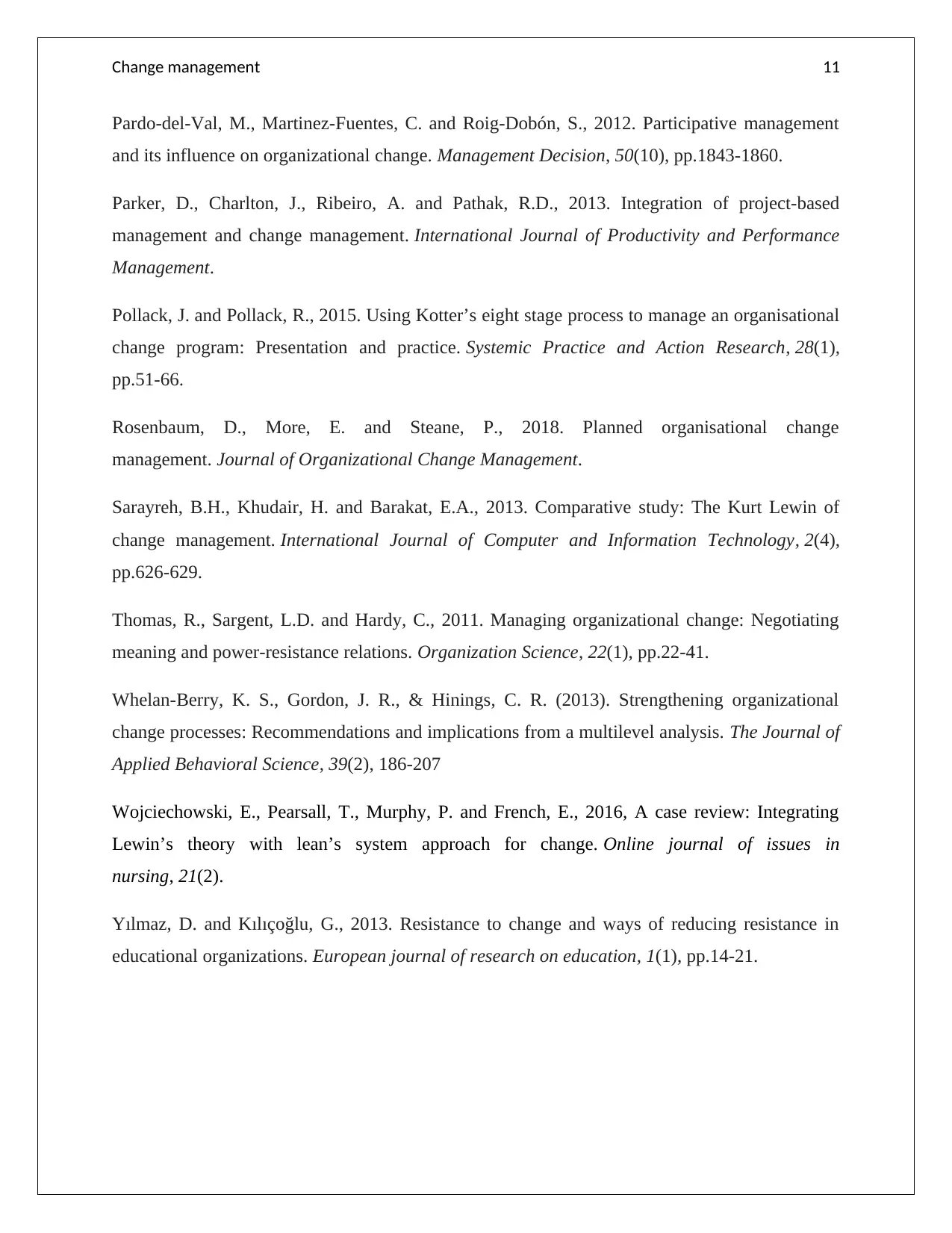
Change management 11
Pardo-del-Val, M., Martinez-Fuentes, C. and Roig-Dobón, S., 2012. Participative management
and its influence on organizational change. Management Decision, 50(10), pp.1843-1860.
Parker, D., Charlton, J., Ribeiro, A. and Pathak, R.D., 2013. Integration of project-based
management and change management. International Journal of Productivity and Performance
Management.
Pollack, J. and Pollack, R., 2015. Using Kotter’s eight stage process to manage an organisational
change program: Presentation and practice. Systemic Practice and Action Research, 28(1),
pp.51-66.
Rosenbaum, D., More, E. and Steane, P., 2018. Planned organisational change
management. Journal of Organizational Change Management.
Sarayreh, B.H., Khudair, H. and Barakat, E.A., 2013. Comparative study: The Kurt Lewin of
change management. International Journal of Computer and Information Technology, 2(4),
pp.626-629.
Thomas, R., Sargent, L.D. and Hardy, C., 2011. Managing organizational change: Negotiating
meaning and power-resistance relations. Organization Science, 22(1), pp.22-41.
Whelan-Berry, K. S., Gordon, J. R., & Hinings, C. R. (2013). Strengthening organizational
change processes: Recommendations and implications from a multilevel analysis. The Journal of
Applied Behavioral Science, 39(2), 186-207
Wojciechowski, E., Pearsall, T., Murphy, P. and French, E., 2016, A case review: Integrating
Lewin’s theory with lean’s system approach for change. Online journal of issues in
nursing, 21(2).
Yılmaz, D. and Kılıçoğlu, G., 2013. Resistance to change and ways of reducing resistance in
educational organizations. European journal of research on education, 1(1), pp.14-21.
Pardo-del-Val, M., Martinez-Fuentes, C. and Roig-Dobón, S., 2012. Participative management
and its influence on organizational change. Management Decision, 50(10), pp.1843-1860.
Parker, D., Charlton, J., Ribeiro, A. and Pathak, R.D., 2013. Integration of project-based
management and change management. International Journal of Productivity and Performance
Management.
Pollack, J. and Pollack, R., 2015. Using Kotter’s eight stage process to manage an organisational
change program: Presentation and practice. Systemic Practice and Action Research, 28(1),
pp.51-66.
Rosenbaum, D., More, E. and Steane, P., 2018. Planned organisational change
management. Journal of Organizational Change Management.
Sarayreh, B.H., Khudair, H. and Barakat, E.A., 2013. Comparative study: The Kurt Lewin of
change management. International Journal of Computer and Information Technology, 2(4),
pp.626-629.
Thomas, R., Sargent, L.D. and Hardy, C., 2011. Managing organizational change: Negotiating
meaning and power-resistance relations. Organization Science, 22(1), pp.22-41.
Whelan-Berry, K. S., Gordon, J. R., & Hinings, C. R. (2013). Strengthening organizational
change processes: Recommendations and implications from a multilevel analysis. The Journal of
Applied Behavioral Science, 39(2), 186-207
Wojciechowski, E., Pearsall, T., Murphy, P. and French, E., 2016, A case review: Integrating
Lewin’s theory with lean’s system approach for change. Online journal of issues in
nursing, 21(2).
Yılmaz, D. and Kılıçoğlu, G., 2013. Resistance to change and ways of reducing resistance in
educational organizations. European journal of research on education, 1(1), pp.14-21.
⊘ This is a preview!⊘
Do you want full access?
Subscribe today to unlock all pages.

Trusted by 1+ million students worldwide
1 out of 12
Related Documents
Your All-in-One AI-Powered Toolkit for Academic Success.
+13062052269
info@desklib.com
Available 24*7 on WhatsApp / Email
![[object Object]](/_next/static/media/star-bottom.7253800d.svg)
Unlock your academic potential
Copyright © 2020–2025 A2Z Services. All Rights Reserved. Developed and managed by ZUCOL.





